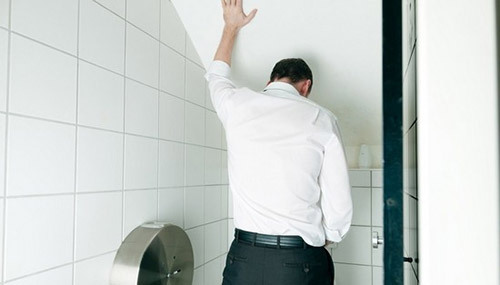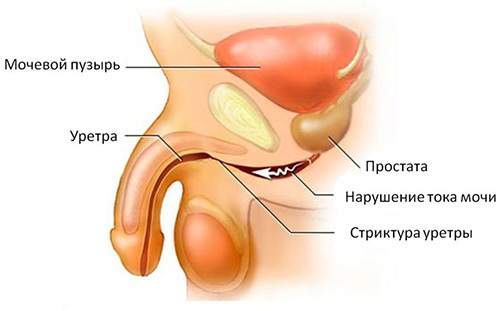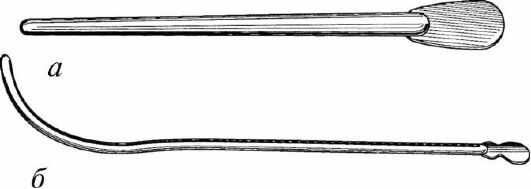How to diagnose and treat a kidney injury?
Kidney injury is a type of injury that results in a violation of the integrity of the renal parenchyma and other surrounding tissues. This is not the most frequent condition in urological practice: the kidney bruises account for about 3% of calls to the doctor. At the same time, the total frequency of renal lesions in peacetime is 1 to 10%( according to various estimates) in the structure of all closed injuries of various structures of the urinary system.
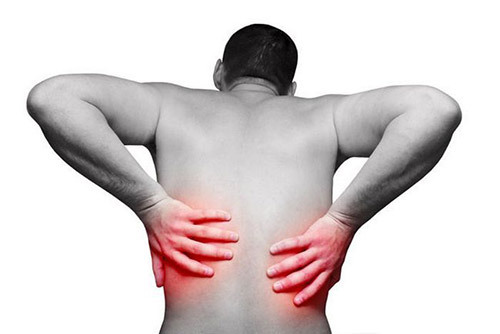
Since the kidneys are literally permeated with nerve endings, even a slight mechanical effect on the organ results in intense pain
- 1 Contents
- 1 Definition
- 2 Risk Factors and Groups
- 3 Causes of development
- 4 Symptoms
- 5 Severity
- 6 Diagnostic measures
- 7 First aid
- 8 Treatment
- 9 Possible complications
- 10 Prevention
Definition
Kidney injury is a closed blunt trauma to the urinary system with damage to the renal parenchymaS and deep-lying structures( including the cerebral layer, pelvis, etc.).
Risk Factors and Groups
As experts note, the damage of this kind is the most susceptible:
- Persons living in rural areas. According to statistics, it is they who are most often diagnosed with blunt injuries of the kidney tissues.
- Athletes. Due to significant physical exertion, they are at high risk for many diseases. Not the least role is played by an increased risk of injury.
- Persons engaged in extreme leisure: paratroopers, motorcyclists, etc.
- Drivers. In view of the increased risk of getting into a traffic accident.
- Affiliation to the male sex. The ratio between men and women is 3: 1.This is due to the fact that men are more likely to risk their lives and health, and also less attentive to their own organism.
The groups noted here are not a complete list. However, it is the persons from the categories that are most often victims.
Causes of development of
In all cases, the immediate cause is the intense mechanical action on the organ tissues. Among the particular factors can be identified:
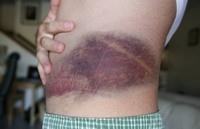
Hematoma from injury
- Hit in an accident. As a result of a strong impact, there is instantaneous intensive compression of the kidneys and organs of the abdominal cavity.
- Fall from a height to a hard surface.
- Injuries received in everyday life( during a fight, etc.).
- Cross bumps at the waist. Just fall into the area of the kidneys.
- Squeezing the abdomen and loin. More often lead to tears, than to bruised injuries.
Symptoms
Symptomatic is typical of and includes:
- Pain syndrome. Since the kidneys are literally permeated with nerve endings, even a slight mechanical effect on the organ leads to intense pain. Discomfort is localized in the lumbar region from the affected side, gives to the legs, genitals, pubic region, lower abdomen. The nature of pain is sharp, piercing, pulsing.
- Isolation of blood in the urine. Also called hematuria. The cause of hematuria is the damage to the small blood vessels of the kidney parenchyma. Paradoxically, it is not always possible to judge by the intensity of bleeding about the severity of the injury. In the event of a traumatic kidney from the blood vessels, hematuria is absent.
- Detection of swelling in the lower back( in the projection of the organ lesion).Swelling is caused by a hematoma.
- Feeling of weakness, weakness.
- A sharp drop in blood pressure( or vice versa, a rapid jump upward).
- Pale skin and mucous membranes.
- Nausea.
- Vomiting.
- Bloating out of flatulence.
- Disorders of bowel movement.
- Abdominal pain.
- Respiratory disorders( with fracture of the ribs).
- Feeling of heaviness and raspiraniya in the abdominal cavity.
In case of an acutely current process, hyperthermia( within 39 degrees) is possible.
Severity of affection
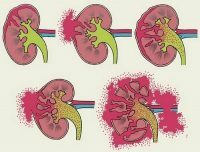
Degree of a kidney injury
Determined by the specialized AAST scale. According to the presented technique, four types of severity of kidney injuries are distinguished:
- A bruised injury without a kidney rupture.
- Small ruptures without exit of urine into the abdominal cavity.
- Rupture of the kidney with urine output and damage to the main vessels.
- Multiple discontinuities and disturbances in the connection of the kidney to the blood vessels.
As far as can be judged, a bruise refers to minor injuries. However, it requires careful diagnosis and treatment.
Diagnostic measures
If the patient is conscious, the first thing to be done is an oral interrogation and a history of life. Diagnosis and treatment of similar pathologies are performed by urologists or nephrologists( not to be confused with neurologists).A major role is played by concomitant kidney diseases, since they can significantly complicate the treatment. With caution, physical examination is carried out( it is important that it is conducted with caution, a great risk to aggravate the course of the pathological process).The following activities are urgently indicated:
- CT or MRI.Allows to reveal all pathological changes of the organ.
- General analysis of urine. It makes it possible to determine the blood in urine.
- Measurement of the hematocrit level.
- Measurement of the level of creatinine.
- Radiography of the kidneys. To exclude more severe damage to the structure of the organ.
- Ultrasonography. Ultrasound is an inexpensive, but quick and informative method of diagnosis.
- Urography.
- Angiography. Detects the damage of the main vessels and allows to determine the nature and degree of blood supply to the damaged kidney.
- Radioisotope study. It is shown for the evaluation of the functional activity of the organ.
Research should be carried out immediately from the time the patient enters the hospital.
First aid
- Provide complete peace.

First aid after a kidney injury - cold compress on the affected area( ice-warmer)
- Eliminate movement from the patient.
- Attach a hot-water bottle to the affected area with ice( pre-wrapped with a cloth).
Treatment of
The goal of therapy is to preserve the functions of the organ and at the same time to conduct minimal invasive intervention in the body. The therapy is predominantly conservative and includes:
- Rest assured to the damaged organ. Showing bed rest and changing the regime of water consumption in the direction of decrease.
- Application of analgesics. Allow to eliminate pain syndrome.
- At the first moment after an injury to relieve the condition and stop bleeding, a cold compress is shown on the affected area( preferably with ice).
- At the end of the acute period, physiotherapy is indicated for the best regeneration of tissues.
Read on: How to maintain kidney health in a natural way?
Possible complications of
- Development of internal bleeding.
- Hematoma.
- Secondary infections. Necrosis of renal structures.
- The formation of malignant hypertension.
Prevention
The task of prevention is to prevent the impact of a traumatic mechanical factor.
Kidney injury - only a conditionally minor injury. In fact, this is a painful condition, which is dangerous for health and life, if it is not timely eliminated. It is important to undergo treatment under the supervision of a competent urologist or nephrologist. Only so the forecast will be favorable.
Read: Kidney diseases and their symptoms in men
Recommended viewing:

